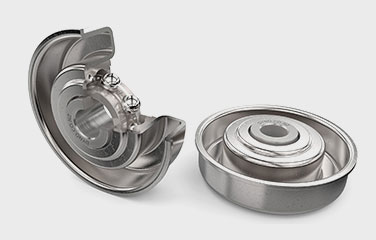News
Ningbo Hardchn bearing Co., Ltd.
Contact Us
Ningbo Hardchn bearing Co., Ltd.
ADD:No.501 Shizhu Rd, Linyu Foreign Investment Park, Jiaochuan Street, Zhenhai District, Ningbo city, China.
Tel:0086-574-86365365
Mobile:0086-(0)13858288142
Fax:0086-574-86454078
In professional production and measurement units, speci […]
In professional production and measurement units, special instruments are used to measure the radial runout of rolling bearings. When using the unit, you can use a simple method to measure if necessary to get an approximate value. The following introduces related instruments and measurement methods.
1. Measuring method of radial clearance
Simple measurement method
① Feeler gauge measurement method
Use a feeler gauge to insert between the roller and the outer ring. When you can insert it with a little force, the thickness of the feeler gauge used is the radial clearance at that position. Rotate the inner ring of the bearing, measure 3 points evenly on a circumference, and take the average value as the measurement result.
a) Oligoscale measurement method; b) Feeler gauge measurement method; c) Economic pressure fuse measurement method; d) Micrometer measurement method;
② Extrusion fuse measurement method
Insert a piece of fuse with a fuse (commonly known as a fuse) into the gap between the two balls and hold it by hand, fix the inner ring of the bearing, rotate the outer ring, so that the fuse is squeezed between the outer ring and the ball, after squeezing, remove the fuse For wire, measure the thickness of the extruded part with an outside micrometer, that is, the radial free size of the bearing. Since the squeezed part of the fuse may have a certain amount of "bounce" after it is withdrawn, the measured value will be slightly larger than the actual clearance value.
③ Dial indicator measurement method

a. Press the inner ring of the bearing on a flat plate that is perpendicular to the horizontal plane. A layer of sheet is placed under the inner ring so that the outer ring does not contact the flat plate and sags by its own gravity. Gently rotate the outer ring of the bearing to make The ball is in contact with the center line of the inner ring and outer ring channel.
b. In the free state of the above-mentioned bearing, align the probe of the dial indicator to the middle of the upper side of the outer surface of the bearing outer ring. After adjusting the measuring force of the dial indicator, turn the cover to make the pointer align to the zero position ( When using a digital dial indicator, set the displayed value to zero).
c. Hold the lower end of the outer ring, and use appropriate force to push it in the radial direction of the bearing (vertically upwards) toward the end B, so that the ball is in close contact with the inner and outer rings in the A direction. Record the reading of the dial indicator. This reading is the radial clearance of the tested bearing at this position.
d. Rotate the outer ring to a certain angle, and then repeat the above operation to obtain several radial clearance values at different angles. Take the average value as the final result.
2. Simple measuring method of axial clearance
The axial clearance of rolling bearings is generally limited to radial ball bearings with relatively fixed inner and outer rings, which can be measured with special instruments. In the unit of use, the following simple methods are generally used.
Simple measurement method of axial clearance of deep groove ball bearing
(1) Press the inner ring of the bearing on a platform, and padded a layer of sheet under the inner ring so that the outer ring does not touch the platform when it sinks naturally under the action of its own gravity. Use a dial indicator at the center of the outer ring end face Measure a point of value every 90° on the entire circumference of the circle and make a record, and measure it with a dial indicator
The pressure on the bearing should be as small as possible to prevent the other end from lifting.
(2) Pull up the bearing outer ring as a whole and keep it stable (supported by cushions), and use the same method and requirements to measure the same 4 points.
(3) Calculate the difference between the two measured values at each point, and take the average of the absolute values, which is the final result of the measured bearing axial clearance.